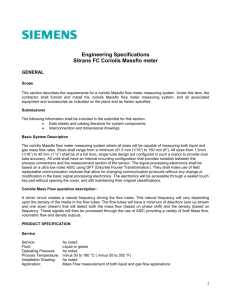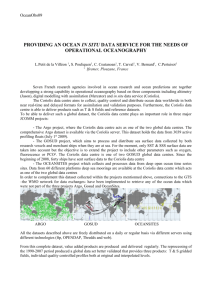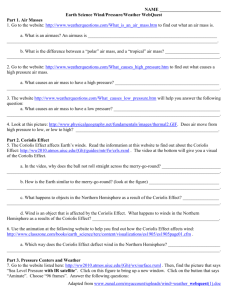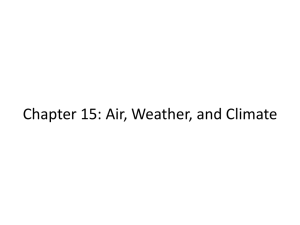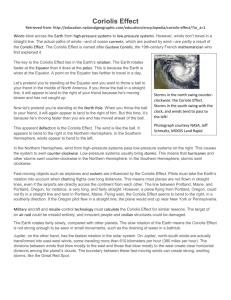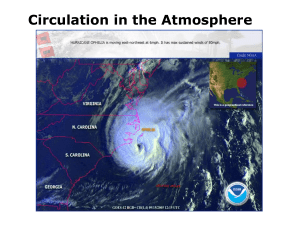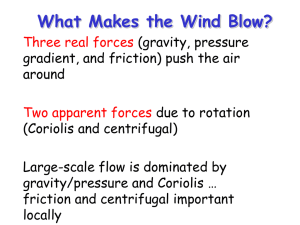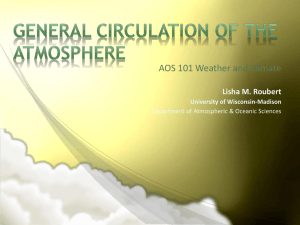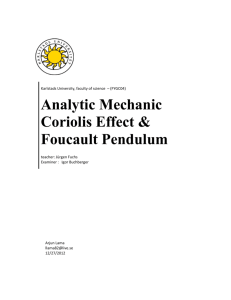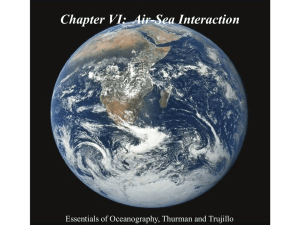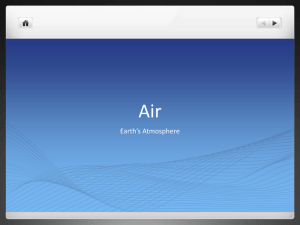Coriolis Flow Meter Theory of Operation
advertisement
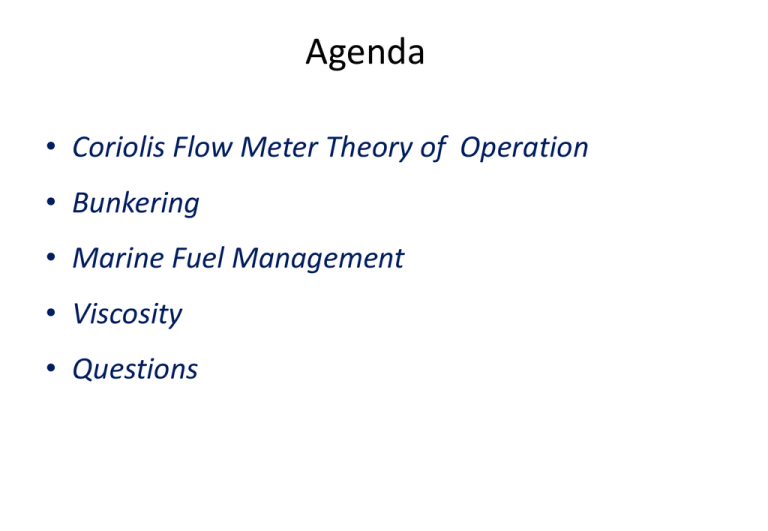
Agenda • Coriolis Flow Meter Theory of Operation • Bunkering • Marine Fuel Management • Viscosity • Questions Coriolis Flowmeter Technology Direct mass measurement is insensitive to fluid properties such as: • Temperature 22 °C (40°F) Change • Pressure 1027L 1000L • Density The same amount of fluid (1 Tonne) looks like 2.7% (~$18) difference with volumetric measurement $54,000 difference on a 3000 Tonne bunker 1 Tonne $654 Bunkers sold on mass but measured by inferred volume 2 Source: Bunkerworld, April 28th 1 Tonne. $654 Theory of Operation • The Coriolis effect is an inertia force. • In 1835, Gustave-Gaspard de Coriolis showed that this inertia force must be taken into consideration if the simple Newton’s Law of Motion of bodies are to be used in a rotating frame of reference. Gasparde de Coriolis Coriolis Effect: The original path is deflected westward by the rotation of the planet Typical Components of a Coriolis Meter Theory of Operation – Mass Flow • In a Coriolis meter, the inertial force is provided by vibrating the flow tubes. The tube twist or angle of deflection from the vibration plane is measured and converted into a mass flow measurement. Micro Motion Confidential Page 5 Theory of Operation – Mass Flow • Process fluid enters the sensor and flow is split with half the flow through each tube. The sensor flow tubes are vibrated in opposition to each other by energizing a drive coil. Tubes are oscillated at their natural frequency. • Magnet and coil assemblies, called pick-offs, are mounted on the flow tubes. As each coil moves through the uniform magnetic field of the adjacent magnet it creates a voltage in the form of a sine wave. Micro Motion Confidential Page 6 Theory of Operation – Mass Flow • • During a no flow condition, there is no Coriolis effect and the sine waves are in phase with each other. When fluid is moving through the sensor's tubes, Coriolis forces are induced causing the flow tubes to twist in opposition to each other. The time difference between the sine waves is measured and is called Delta-T which is directly proportional to the mass flow rate. Theory of Operation – Mass Flow • The Flow Calibration Factor consists of 10 characters, including two decimal points. – The first five digits are the flow calibration factor. This calibration factor, multiplied by a given Delta-T, yields mass flow rate in grams/sec. – The last three digits are a temperature coefficient for the sensor tube material. This coefficient compensates for the effect of temperature on tube rigidity (% change in rigidity per 100°C). Three wire platinum RTD measures tube temperature on inlet side of sensor – – Accurate to +/- 1.0oC Available as additional process variable Applies to liquid and gas, and is linear throughout the entire range of the meter RTD Micro Motion Confidential Page 8 Theory of Operation - Density Theory of Operation -Temperature Coriolis Multi-Variable Capability Three process variables measured independently Direct Mass Flow On-Line Density Temperature Coriolis Technology Multi-Variable Measurement Capability • Density-dependant variables are also available as either; – Standard Curves (Brix, API, HFCS, etc) – Customer-specific Curves (% Mass, % Volume, Alcohol, etc) Degrees API Degrees Baume Degrees Brix Degrees Plato % Solids % Mass % Black Liquor Concentration Specific Gravity Alcohol % HFCS SCFM Mass Flow Volume Flow Density Specific Gravity % Solids By Volume Net Solids Temperature Temperature % Solids By Mass Mass Flow Theory of Operation - Volume • Volumetric Flow is a calculated variable. Volume Flow Mass Flow Densit y • Volume can be referenced to standard temperature using the temperature input. • Coriolis meters are preferred for volume measurements. – – – – Low pressure drop Wide turndown High accuracy High degree of linearity Coriolis Sensor Geometries • All Geometries are not created equal • Design trade-offs are made for such things as; – – – – – – – Flow sensitivity & turndown Density accuracy Fluid S.G. range (gas/liquid) Materials of construction Temperature effects Drainability and Cleanability Pressure limits Why Coriolis – Volume Measurement • Coriolis meters are unaffected by flow profiles, and provide higher turndown than a typical Orifice plate, Vortex Flow conditioner or Turbine velocity-based volumetric meters 42 D No straight run 6D No Reynolds # Limits No parts to wear out Limits leak points/fugitive emissions Lower life cycle costs Low installed costs Marine Industry Applications • Fuel Bunkering • Engine Fuel Control • Fuel Viscosity Navy Supply Platform Pleasure Cruise Cargo Ship Benefits of a 1% Measurement Improvement • Bunker fuel represents 50-70% of total ship operating expense Example: Large container ship-7,750 TEU – Summer 2010 $455/tn*200tn/day*200 days operating = $18.2M – Winter 2011 bunkers $655tn*200tn/day*300 days operating = $39.3M – Next summer ???? • What does a 1% measurement improvement mean to you? – Last summer $182K potential savings – Now $393K potential savings – Reduced billing discrepancies The technology is here today that can benefit suppliers, barge operators and shipping companies
